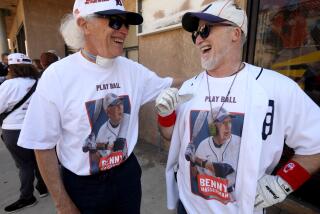Jerry Sacharski dies at 93; he pioneered T-ball as an organized youth sport
Jerry Sacharski, a recreation league director who pioneered T-ball as an organized youth sport in the 1950s because he couldn’t bear to turn away young children who clamored to play baseball, has died. He was 93.
Sacharski, who was a retired high school teacher, died Friday of natural causes at his home in Albion, Mich., said a spokeswoman for the J. Kevin Tidd Funeral Home.
“We had all these little guys coming out for summer baseball five years ago,” Sacharski told United Press International in 1960, “and just couldn’t send them home.”
To help younger children learn the fundamentals of baseball, he removed one of the sport’s more difficult aspects -- pitching and hitting the ball -- and devised rules that allowed a batter to hit the ball off an adjustable tee on home plate.
After fashioning his first batting tee out of metal piping, pieces of rubber and part of a garden hose, Sacharski invited youngsters between ages 6 and 8 to come out for a suddenly pitchless pastime.
On June 25, 1956, what Sacharski initially called “pee-wee baseball” debuted in a league game at a park in Albion, about 100 miles west of Detroit.
“You won’t find an earlier date for a tee being used in a game,” said Frank Passic, an Albion historian.
Sacharski resisted being called the inventor of the game and would only allow that he founded what “may have been the first organized tee-ball league.”
Several men did claim to be the father of the game, including a Florida minister who trademarked the phrase “tee-ball” and said he invented it in 1960.
In Los Angeles, T-ball was played as early as 1958, The Times reported in 1963, and at least two men have been credited with inventing it here.
It seems the simplified game first played by the little boys of summer has something in common with its big brother.
“T-ball, of course, is just like baseball -- nobody knows who invented it first,” said Tim Wiles, director of research at the National Baseball Hall of Fame & Museum.
Sacharski wasn’t interested in receiving credit for creating T-ball or marketing it but “was there to teach the kids,” said Passic, a member of a 1960 Albion pee-wee team called Johnny Ringo, named for a TV western.
While the game was in its infancy, Sacharski took Albion pee-wee players to Michigan State University in 1960 to stage an hourlong exhibition game to educate the public “about this new sporting phenomenon,” Passic later wrote.
More than 2 million children play T-ball across the country today, according to the T-Ball USA Assn.
When the Pittsburgh Press ran an article in 1960 about the demonstration game, which was televised on a Michigan station, the headline said: “Pee-Wees Use Tee For Batting; Pitcher And Catcher Missing.”
Jerome Sacharzewski was born Feb. 6, 1916, in West Allis, Wis., to Michael and Martha Sacharzewski. He simplified his name to Sacharski so that it would fit on a baseball score card, Passic said.
At Oshkosh State Teacher’s College, Sacharski met his future wife, Etola Lacy, and they married in 1941.
He served in the Army during World War II and moved to Albion in 1942 to work as an athletic director and coach at Starr Commonwealth, a private school.
In 1951, he joined the Albion public schools and taught Latin, history and literature until retiring in 1980.
After volunteering to direct the summer baseball program in 1954, Sacharski later said that it was clear he needed a plan to “introduce little guys” to baseball.
At the Albion league’s 50th anniversary reunion in 2006, Sacharski recalled, “The greatest kick I ever got was teaching kids how to start out.”
In addition to his wife, Sacharski is survived by three sons, David of Bay Village, Ohio, Michael of Honolulu, and William of Flushing, Mich.; four grandchildren, one great-grandchild; and a brother, Raymond, of Sussex, Wis.
More to Read
Start your day right
Sign up for Essential California for the L.A. Times biggest news, features and recommendations in your inbox six days a week.
You may occasionally receive promotional content from the Los Angeles Times.







